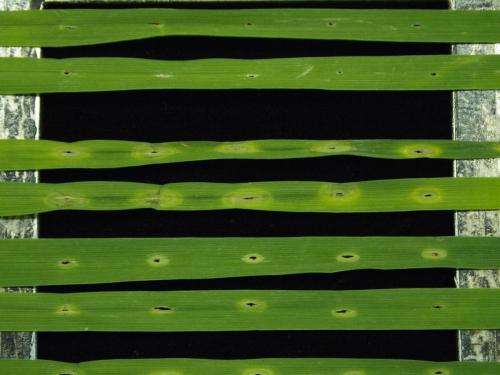Scientists transfer pathogen-sensing 'antenna' gene to wheat

A team of scientists from the John Innes Centre (JIC), the National Institute of Agricultural Botany (NIAB) and The Sainsbury Laboratory (TSL) have successfully transferred a receptor that recognises bacteria from the model plant Arabidopsis thaliana - a dicot, to wheat - a monocot. They showed that the receptor can trigger a defensive response and confers increased resistance to bacterial disease. The research findings demonstrate that the signalling pathways or circuitry downstream of the receptor are conserved between evolutionary distant monocots and dicots.
Drs Henk-jan Schoonbeek and Christopher Ridout, the lead and corresponding authors of a paper published in The New Phytologist today, first developed diagnostic tools which tests wheat for responses to pathogen-associated molecular patterns (PAMPs). These PAMPs are often essential parts of fungi or bacteria - they would find it difficult to mutate or lose them without affecting their fitness or survival. Pattern recognition receptors recognise and confer a response to such PAMPs and could contribute to durable resistance. The authors have demonstrated that wheat has the circuitry to respond to these pathogens but not all the antennae required to perceive pathogens most effectively.
The JIC scientists worked with TSL and the crop transformation team at NIAB to transfer a receptor gene, EFR, conferring recognition of the widespread bacterial protein EF-Tu, from Arabidopsis to wheat, and used their diagnostic tools to show that the receptor was functional. EFR works like a new antenna that activates defence elements already present and makes the wheat plants more resistant to bacteria. Since EF-Tu is essential, the authors predict this type of resistance should be durable. EFR was first identified by Professor Cyril Zipfel, Head of TSL, and co-author of the paper. Prof Zipfel pioneered inter-species transfer of PRRs, and recently reported a converse transfer of a monocot PRR to dicot plants, further illustrating the ancient evolutionary conservation of immune signalling between these plant classes.
Bacterial wheat diseases are widespread in Asia and Africa , and present in the USA. The diagnostic tool can be used immediately to help breeders screen seed varieties for PAMP recognition, and therefore resistance to multiple bacterial pathogens.
Chris Ridout said: "Our work demonstrates the importance of developing this type of resistance in wheat. As the wheat genome is sequenced further and we continue our analysis of receptor genes in dicots, we hope to identify more genes that can be used to develop durable resistance, not only to bacterial diseases, but to the most important fungal pathogens of wheat such as yellow rust, Septoria and powdery mildew."
More information: The paper has been published on The New Phytologist website at: onlinelibrary.wiley.com/doi/10.1111/nph.13356/full
Journal information: New Phytologist
Provided by Norwich BioScience Institutes




















